Cookbook Collaborators:
Caroline Fors
Martha Levenson
Holly Winters
Our collective project illustrates the joys and challenges faced by researchers working with non-English speakers, or English as a second language speakers, and the way in which language plays a key role in the production and circulation of meaning. Conducting research with non-English speakers requires a self-reflective awareness of our own cultural values and judgments, a thoughtful translation of cultural codes, and a careful process of negotiation over meaning.
Our work also addresses the issue of reflexivity. Each of us speaks at least two languages. Working in another language influences thought process, identity construction, placement of ourselves as researchers in the larger context of the world, and our knowledge and insight into other cultures. All of these in turn have bearing on reflexivity, a critical point in research.
This blog is also intended to help academics and cultural practitioners working with non-English speakers, or English as a second language speakers, to become more conscious of the challenges involved in such a research process. The artifacts represented, and the stories attached to them, illustrate the ways in which spaces and
traditions are conceptualized as unique, local, or as national identities.
The MACS program emphasizes collaboration and as such, has given us many opportunities to work in groups and to practice such an approach in our classes. As a result, each one of us strives to use a collaborative approach in our capstone project. The readings by scholars such as Don Mitchell, Doreen Massey, and Stuart Hall have been particularly useful in engaging our reflexivity in terms of our capstone project, and have also very relevant within the framework of this collaboration. We would like to bring in others who speak more languages and would like to invite anyone who has an interest in languages to participate.
Martha’s work will continue in schools and at the Nordic Heritage Museum. As a docent, she uses language facility as a way to portray the terror of immigrants at Ellis Island. In working with the outreach trunks at the Museum, the Nordic words are used in appropriate places, and translations given, so that students can see how language goes with culture. She hopes to do more language study, particularly in Swedish, as part of her doctoral work, and eventually, to do some research on informal learning in Sweden.
This project intersects with Caroline’s future work as she intends to continue contributing to the well-being of communities located in the Global South. Language barriers, the negotiation over meaning, and representation will be an ongoing process in her future work.
Holly’s future work includes developing a language school/community center that will feature bilingual education programs for Latino cultures and English speakers who wish to learn Spanish, along with providing a resource center and gathering space for tutoring, cultural events, open mic, coffee and other neighborhood activities. The acquisition of another language must be accompanied by an application for it, and a crucial aspect of her capstone will be to clearly demonstrate the importance of also understanding the culture from which the language originates.
Multilingual Cookbook
Thursday, November 11, 2010
El muelle de San Blas - Maná (by Holly)
I really love this song. English translation included.
EL MUELLE DE SAN BLAS - Maná
Ella despidió a su amor
El partió en un barco en el muelle de san Blas
él juró que volvería
y empapada en llanto ella juró que esperaría..
miles de lunas pasaron
y siempre ella estaba en el muelle
esperando..
Muchas tardes se anidaron
se anidaron en su pelo
y en sus labios
Llevaba el mismo vestido
y por si él volviera no se fuera a equivocar.
Los cangrejos le mordían
su ropaje, su tristeza y su ilusión..
y el tiempo se escurrió
y sus ojos se le llenaron de amaneceres
y del mar se enamoró
y su cuerpo se enraizó
en el muelle
Sola
sola en el olvido
sola
sola con su espíritu
sola
sola con su amor el mar
sola
en el muelle de san Blas
Su cabello se blanqueó
pero ningún barco a su amor le devolvía,
y en el pueblo le decían
le decían la loca del muelle de san Blas.
Y una tarde de abril
la intentaron transladar al manicomio;
nadie la pudo arrancar
y del mar nunca jamás la separaron.
Sola
sola en el olvido
sola
sola con su espíritu
sola
sola con su amor el mar
sola
en el muelle de san Blas
Sola en el olvido
Sola con su espíritu
Sola con su amor el mar
Sola
sola en el olvido
sola
sola con su espíritu
sola
sola con su amor el mar
sola
en el muelle de san Blas
Se quedó
Se quedó
Sola, sola
Se quedó
Se quedó
con el sol y con el mar
Se quedó ahí
Se quedó hasta el fin
se quedó ahí
se quedó en el muelle de san Blas
Sola, sola, sola
THE WHARF OF SAN BLAS - Maná
She bid farewell to her love
He departed on a ship at the wharf of San Blas
He swore that he would return
And soaked from weeping she swore that she would wait
Thousands of moons passed
and always she was at the rocks waiting...
Many afternoons they were together
They were together in her hair
and in her lips
She wore the same dress
For if he returned he would not mistake her
The crabs would attack her
her dress, her sadness and her illusion
And time was drying up
and her eyes were filled with daylight
and she loved the sea
and her body became roots
at the seashore
Alone, alone in oblivion
Alone, alone with her spirit
Alone, alone with her love, the sea
Alone, at the wharf of San Blas
Her hair went white
But not a ship from her love returned to her
and in the town they were saying,
They were saying she is the crazy lady from san Blas
And one afternoon in April
they tried to move her to an insane asylum
Nobody was able to tear her roots from the ground
and she was never ever separated from the sea
Alone, alone en oblivion
Alone, alone with her spirit
Alone, alone with her love, the sea
Alone, alone at the wharf of San Blas
She stayed, she stayed alone
with the sun and with the sea
she stayed like that
She stayed until the end
She stayed like that in the wharf of San Blas
EL MUELLE DE SAN BLAS - Maná
Ella despidió a su amor
El partió en un barco en el muelle de san Blas
él juró que volvería
y empapada en llanto ella juró que esperaría..
miles de lunas pasaron
y siempre ella estaba en el muelle
esperando..
Muchas tardes se anidaron
se anidaron en su pelo
y en sus labios
Llevaba el mismo vestido
y por si él volviera no se fuera a equivocar.
Los cangrejos le mordían
su ropaje, su tristeza y su ilusión..
y el tiempo se escurrió
y sus ojos se le llenaron de amaneceres
y del mar se enamoró
y su cuerpo se enraizó
en el muelle
Sola
sola en el olvido
sola
sola con su espíritu
sola
sola con su amor el mar
sola
en el muelle de san Blas
Su cabello se blanqueó
pero ningún barco a su amor le devolvía,
y en el pueblo le decían
le decían la loca del muelle de san Blas.
Y una tarde de abril
la intentaron transladar al manicomio;
nadie la pudo arrancar
y del mar nunca jamás la separaron.
Sola
sola en el olvido
sola
sola con su espíritu
sola
sola con su amor el mar
sola
en el muelle de san Blas
Sola en el olvido
Sola con su espíritu
Sola con su amor el mar
Sola
sola en el olvido
sola
sola con su espíritu
sola
sola con su amor el mar
sola
en el muelle de san Blas
Se quedó
Se quedó
Sola, sola
Se quedó
Se quedó
con el sol y con el mar
Se quedó ahí
Se quedó hasta el fin
se quedó ahí
se quedó en el muelle de san Blas
Sola, sola, sola
THE WHARF OF SAN BLAS - Maná
She bid farewell to her love
He departed on a ship at the wharf of San Blas
He swore that he would return
And soaked from weeping she swore that she would wait
Thousands of moons passed
and always she was at the rocks waiting...
Many afternoons they were together
They were together in her hair
and in her lips
She wore the same dress
For if he returned he would not mistake her
The crabs would attack her
her dress, her sadness and her illusion
And time was drying up
and her eyes were filled with daylight
and she loved the sea
and her body became roots
at the seashore
Alone, alone in oblivion
Alone, alone with her spirit
Alone, alone with her love, the sea
Alone, at the wharf of San Blas
Her hair went white
But not a ship from her love returned to her
and in the town they were saying,
They were saying she is the crazy lady from san Blas
And one afternoon in April
they tried to move her to an insane asylum
Nobody was able to tear her roots from the ground
and she was never ever separated from the sea
Alone, alone en oblivion
Alone, alone with her spirit
Alone, alone with her love, the sea
Alone, alone at the wharf of San Blas
She stayed, she stayed alone
with the sun and with the sea
she stayed like that
She stayed until the end
She stayed like that in the wharf of San Blas
From Rosa Maria (by Holly)
On the very first leg of my very first trip to Argentina, I met a woman named Rosa Maria. She was traveling from Seattle back to Houston, TX where she would then head south to Mexico. We were sitting next to one another on the plane, and I was confident enough with my Spanish to engage her in conversation. I told her I was on my way to Buenos Aires where I would be studying Spanish for the next few months, and she was surprised and impressed that someone like me wanted to learn Spanish. She told me about her time in Seattle, and before we disembarked she handed me a note:

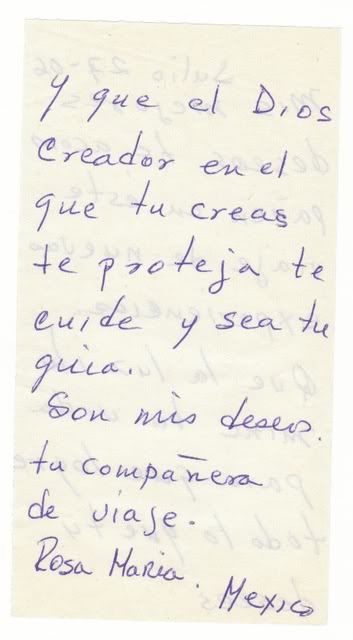
July 27, 2006
My best wishes accompany you on this journey of new experiences. May light illuminate your life so that you achieve all that you desire, and may whatever God in which you believe protect you, care for you and be your guide. These are my wishes.
Your traveling companion,
Rosa Maria
Mexico
Kind people like Rosa Maria exist all over the world, and my belief is that the United States ought to embrace and welcome Spanish/English bilingual education. Rosa Maria didn't speak any English, but that didn't stop me from getting to know a lovely human being while trapped in a flying tin can. That brief exchange between two travelers was a poignant moment in my journey, and it gave me confidence to face the long road ahead of me. I will always remember Rosa Maria. She is a Latina, a woman and a gentle soul, and she reinforced my desire to become bilingual.


July 27, 2006
My best wishes accompany you on this journey of new experiences. May light illuminate your life so that you achieve all that you desire, and may whatever God in which you believe protect you, care for you and be your guide. These are my wishes.
Your traveling companion,
Rosa Maria
Mexico
Kind people like Rosa Maria exist all over the world, and my belief is that the United States ought to embrace and welcome Spanish/English bilingual education. Rosa Maria didn't speak any English, but that didn't stop me from getting to know a lovely human being while trapped in a flying tin can. That brief exchange between two travelers was a poignant moment in my journey, and it gave me confidence to face the long road ahead of me. I will always remember Rosa Maria. She is a Latina, a woman and a gentle soul, and she reinforced my desire to become bilingual.
Cultural research through language immersion (by Holly)
The Cookbook Linguists collaborating on this project have cited and agree that "language plays a key role in the production and circulation of meaning" (Caroline). My experiences studying abroad as an undergraduate have shaped my research in an empirical way, and have inspired my cultural studies capstone to include developing a curriculum for my own private language school. I participated in four separate language immersion programs in three countries, spending a total of nine months living in South America, and I have a solid idea of what is possible and can be accomplished in Seattle.
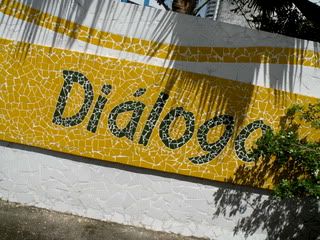
Diálogo - Portuguese language immersion school where I studied for four weeks in Salvador da Bahia, Brasil; April 2009
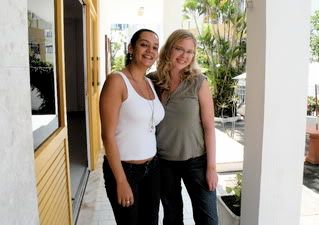
With my Portuguese profesora, Tatiana
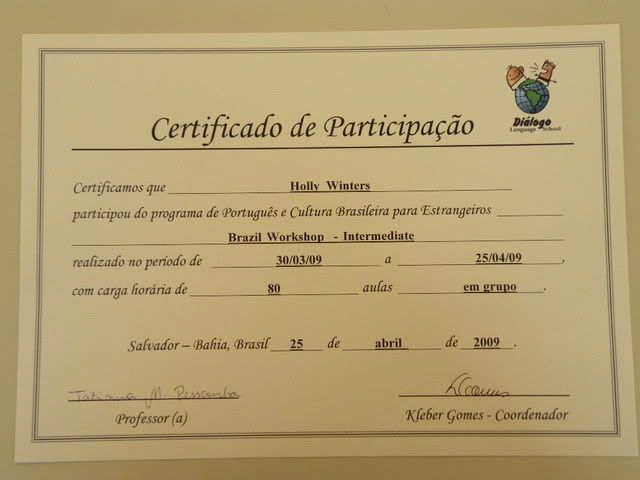
Certificate of Participation

Diálogo - Portuguese language immersion school where I studied for four weeks in Salvador da Bahia, Brasil; April 2009

With my Portuguese profesora, Tatiana

Certificate of Participation
Academia Uruguay (by Holly)
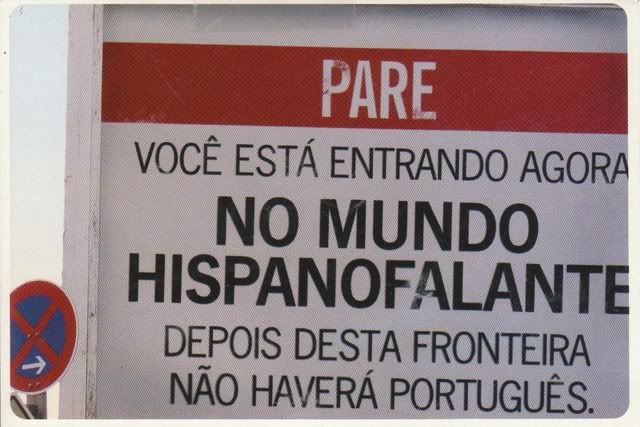
STOP. You are now entering the Spanish-speaking world. From this point there will be no Portuguese.
This is a card that hangs outside the office in a Spanish school called Academia Uruguay. It is a private language school located in the neighborhood Ciudad Vieja, the historical district of Montevideo, Uruguay's capital city. I participated in 40 hours of intensive Spanish classes there, and lived in the attached residencia for two weeks.
Academia Uruguay is an organization that I consider to be an exemplar in my cultural studies research and development of a Spanish/English school and community bilingual center. The school's core values emphasize academic excellence, professional service and complete immersion. These are three simple, yet effective strategies to business management, language acquisition, and community collaboration. The school is relatively new, having only opened in 2007, and it is operated by a young and highly educated staff, many individuals being university students like myself.
Through my personal experience as an international immersion student and language educator, I have already learned that language teaching requires more than dictating verbs and vocabulary in order for students to achieve tangible results. It is imperative that a cultural connection be relevant and apparent. Schools like Academia Uruguay provide international students with a curriculum, support and immediate application of the materials being taught in class.
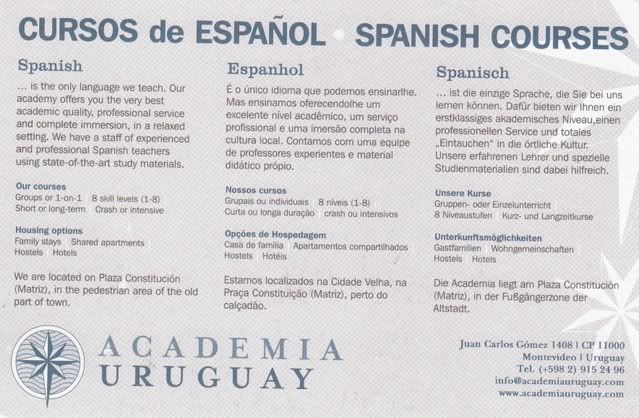
Açaí na tigela - BRASIL (by Holly)
Açaí na tigela (Açaí in a bowl)
Açaí (pronounced ah-sigh-EE) has become popular in the U.S. for very good reason. This traditional snack from Brazil is delicious, nutritious and easy to make. You can buy frozen pureed açaí in supermarkets like Whole Foods or PCC.

Ingredientes:
400g de polpa de açaí congelada
1 banana nanica picada
Suco de 1 laranja
Açúcar refinado ou adoçante
Preparo:
• No copo do liqüidificador, coloque a polpa de açaí semi-gongelada, a banana, o suco de laranja e adoce.
• Bata até que fique homogêneo, mas sem deixar que a polpa derreta por completo.
• Sirva imediatamente.
• Os ingredientes devem ser batidos rapidamente para se obter uma sobremesa gelada com alguns flocos de gelo, e não um líquido.
• Bata a polpa de açaí com outras frutas, como morango, kiwi, etc.
• Acrescente também pó de guaraná
Ingredients:
400g frozen acai pulp
1 chopped banana
Juice from 1 orange or the equivalent amount of apple juice
Sugar or sweetener to taste
Granola
Preparation:
• Place the açaí, banana, orange or apple juice and sugar in a blender.
• Beat until smooth, but without letting the açaí melt completely.
• Serve immediately.
• The ingredients should be tapped quickly to obtain a frozen dessert with a few flakes of ice, and not a liquid.
• Whisk the açaí with other fruits such as strawberries, kiwi
• Add guaraná if desired
• Top with granola
Açaí (pronounced ah-sigh-EE) has become popular in the U.S. for very good reason. This traditional snack from Brazil is delicious, nutritious and easy to make. You can buy frozen pureed açaí in supermarkets like Whole Foods or PCC.

Ingredientes:
400g de polpa de açaí congelada
1 banana nanica picada
Suco de 1 laranja
Açúcar refinado ou adoçante
Preparo:
• No copo do liqüidificador, coloque a polpa de açaí semi-gongelada, a banana, o suco de laranja e adoce.
• Bata até que fique homogêneo, mas sem deixar que a polpa derreta por completo.
• Sirva imediatamente.
• Os ingredientes devem ser batidos rapidamente para se obter uma sobremesa gelada com alguns flocos de gelo, e não um líquido.
• Bata a polpa de açaí com outras frutas, como morango, kiwi, etc.
• Acrescente também pó de guaraná
Ingredients:
400g frozen acai pulp
1 chopped banana
Juice from 1 orange or the equivalent amount of apple juice
Sugar or sweetener to taste
Granola
Preparation:
• Place the açaí, banana, orange or apple juice and sugar in a blender.
• Beat until smooth, but without letting the açaí melt completely.
• Serve immediately.
• The ingredients should be tapped quickly to obtain a frozen dessert with a few flakes of ice, and not a liquid.
• Whisk the açaí with other fruits such as strawberries, kiwi
• Add guaraná if desired
• Top with granola
Wednesday, November 10, 2010
Music as Language (by Martha)
Att jag spelar fiol med barn är inte nyheter. Men, vet ni att det finns en artikel på svenska i sverige om oss som var i en journal för de som spelar fiol i Sverige? Nu har vi den här: (That I play the fiddle is not news. But, did you know that there was an article published in Swedish in Sweden about us in a journal for fiddlers? here it is.) The full translation of the article follows below, courtesy of the Nordic Heritage Museum and Virginia Dublin.
Lilla spelmanslaget Carries on with the Music
On the top floor of the Nordic Heritage Museum there is a large hall. Martha Levenson sits there with five 8 – 10 year olds and trains them in tunes every Tuesday. A couple of parents sit on the side reading, waiting for their children. At the beginning the children tell a little about how the day has been, then Martha gets going.
They practice bowing a hambo by Dahlin. Martha is demanding and the creases in her forehead are deep and focused. The second run through is in two parts. It sounds good and afterwards there is a little talk about bowing.
“Now, you are going to sit on a horse, an elephant or a rhinoceros, but not on a fish or a snake.”
That’s enough on posture.
“We have three rules here”, says Martha. “Have fun, keep the bow going and smile. It doesn’t matter if we make mistakes, just so we follow the rules.”
The Nordic Heritage Museum provides space for the group and owns one of the fiddles that is rented out to a student. The hope is that the museum eventually can build up a complete collection of 1/4, 2/4, 3/4 and full size fiddles.
Then the group plays a gånglåt [walking tune] walking while they fiddle. Anika is of Swedish descent and has enticed a friend to come to the group. A couple of them have played American folk music but think that this group has fun. At the Folklife festival the children received standing ovations. Martha has a long waiting list of children who want to begin.
“Anika knows 20 tunes and three harmonies. Ciara has learned four tunes in a couple of months; she practices on her own at home. All of the children get a CD to practice along with, because we play by ear.”
“ You didn’t practice during the week, did you? Go back and practice because I know you have it. Don’t forget C sharp and D sharp.”
One of the children nods in agreement.
Martha’s criticism is lightning quick and matter-of-fact. The children are focused on remembering, practicing rote and so that it sounds good. No one is made to feel embarrassed. Last summer Lilla spelmanslaget played at Northwest Folklife Festival in Seattle. Before that they had played a dance at a first Friday dance at the Cedar Valley Grange, a community center outside of Seattle.
The rebirth is on the way, fueled by the embers in Martha Levenson who has also taken courses in Sweden several times. She got back her desire to play fiddle when she heard a polska and couldn’t figure out the beat. Now her passion is contagious and the children are a little euphoric when they play a schottis and hop/jump in the air at a certain point. Or when they play a gånglåt while walking.
Good luck, Lilla spelmanslag!
Subscribe to:
Posts (Atom)
